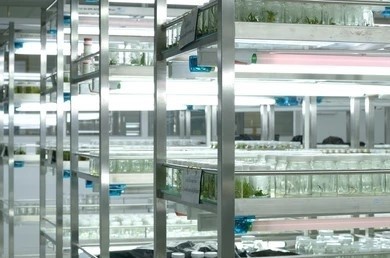Huperziaceae Plant Tissue Culture
Huperziaceae is the oldest surviving group of vascular plants on earth. It is a group of small perennial herbs, native, epiphytic, or borne in mossy layers, preferring cool and moist environments. The family has two genera and about 150 species and is widespread throughout the world, especially in tropical South and Central America.

The whole herb of the Huperziaceae plant can be used as human medicine for treating bruises, muscle spasms, bruising and swelling pain, sciatica, neuropathic headache, and severe pain caused by gallstones. Externally, it is used to treat carbuncles, scabies, and burns, and fires.
Huperziaceae plants reproduce less by reproductive shoots under wild conditions, and the spore germination cycle is long, and it takes 6-15 years to mature after germination as an underground gametophyte, thus greatly limiting the regeneration of wild resources of this family and far from meeting the market demand.
Tissue culture service
Lifeasible provides Huperziaceae plant tissue culture, and high-quality Huperziaceae plant seedlings can be provided for the extraction of HupA (Huperzine A), flavonoids, and other active bioactive components of Huperziaceae plants, clinical applications, and other research processes.
- Huperzia serrata (Thunb.) Trev.
Huperzia serrata has the effects of clearing heat and detoxifying, producing blood and stopping bleeding, dispersing stasis, and reducing swelling, etc. It is mostly used to treat bruises, bruises, swelling and pain, internal injuries and bleeding, etc.
- Phlegmariurus carinatus (Desv. ex Poiret) Ching
Phlegmariurus carinatus belongs to the family Huperziaceae, genus Phlegmariurus, and can be used to treat bruises, muscle spasms, tendon pain, rheumatic joint pain, rheumatoid arthritis, and hypertrophic spondylitis.
In the tissue culture of Huperziaceae plants, Lifeasible usually induces the dedifferentiation of the explants to form healing tissues and the induction of redifferentiation of the healing tissues to form adventitious shoots, adventitious roots, and then complete Huperziaceae plants to achieve quantitative expansion.
- Since Huperziaceae plants are mostly ferns that live in symbiosis with fungi, it is quite difficult to completely remove the fungi from them, so one of the keys to a successful tissue culture of Huperziaceae plants using sporangia, spores, stem tips, and terminal buds as explants is the sterilization of explants, and we have determined a better method for sterilizing Huperziaceae plant explants with our rich experience.
- Another key to the successful tissue culture of Huperziaceae plants is to determine the best medium. For Huperziaceae plants, successful cultivation cannot be achieved by simply relying on plant growth hormones with other nutrients. On this basis, Lifeasible has optimized a medium for the cultivation of Huperziaceae plant explants.
You want to sign a confidentiality agreement.
You have a specific plant species for your experimental needs.
You have a reliable and relevant cooperation project to discuss.
You are very interested in our project or have any questions.
You need an updated and detailed quotation.
For research or industrial use.



